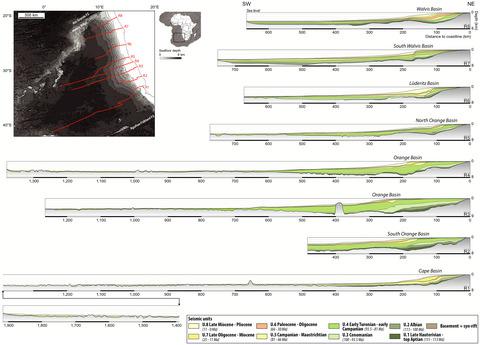当前位置:
X-MOL 学术
›
Basin Res.
›
论文详情
Our official English website, www.x-mol.net, welcomes your feedback! (Note: you will need to create a separate account there.)
Inverting passive margin stratigraphy for marine sediment transport dynamics over geologic time
Basin Research ( IF 3.2 ) Pub Date : 2022-07-24 , DOI: 10.1111/bre.12698 Charles M. Shobe 1, 2 , Jean Braun 2, 3 , Xiaoping Yuan 2, 4 , Benjamin Campforts 2, 5 , Boris Gailleton 2 , Guillaume Baby 6, 7 , François Guillocheau 6 , Cécile Robin 6
Basin Research ( IF 3.2 ) Pub Date : 2022-07-24 , DOI: 10.1111/bre.12698 Charles M. Shobe 1, 2 , Jean Braun 2, 3 , Xiaoping Yuan 2, 4 , Benjamin Campforts 2, 5 , Boris Gailleton 2 , Guillaume Baby 6, 7 , François Guillocheau 6 , Cécile Robin 6
Affiliation

|
Passive margin stratigraphy contains time-integrated records of landscapes that have long since vanished. Quantitatively reading the stratigraphic record using coupled landscape evolution and stratigraphic forward models (SFMs) is a promising approach to extracting information about landscape history. However, there is no consensus about the optimal form of simple SFMs because there has been a lack of direct tests against observed stratigraphy in well-constrained test cases. Specifically, the extent to which SFM behaviour over geologic space and timescales should be governed by local (downslope sediment flux depends only on local slope) versus nonlocal (sediment flux depends on factors other than local slope, such as the history of slopes experienced along a transport pathway) processes is currently unclear. Here, we develop a nonlocal, nonlinear SFM that incorporates slope bypass and long-distance sediment transport, both of which have been previously identified as important model components but not thoroughly tested. Our model collapses to the local, linear model under certain parameterizations such that best-fit parameter values can indicate optimal model structure. Comparing 2-D implementations of both models against seven detailed seismic sections from the Southeast Atlantic Margin, we invert the stratigraphic data for best-fit model parameter values and demonstrate that best-fit parameterizations are not compatible with the local, linear diffusion model. Fitting observed stratigraphy requires parameter values consistent with important contributions from slope bypass and long-distance transport processes. The nonlocal, nonlinear model yields improved fits to the data regardless of whether the model is compared against only the modern bathymetric surface or the full set of seismic reflectors identified in the data. Results suggest that processes of sediment bypass and long-distance transport are required to model realistic passive margin stratigraphy and are therefore important to consider when inverting the stratigraphic record to infer past perturbations to source regions.
中文翻译:

反演地质时期海洋沉积物输运动力学的被动边缘地层学
被动边缘地层学包含了早已消失的景观的时间整合记录。使用耦合景观演化和地层正演模型 (SFM) 定量读取地层记录是提取景观历史信息的一种很有前途的方法。然而,对于简单 SFM 的最佳形式没有达成共识,因为在约束良好的测试案例中缺乏针对观察到的地层学的直接测试。具体来说,地质空间和时间尺度上的 SFM 行为应在多大程度上受局部(下坡沉积物通量仅取决于局部坡度)与非局部(沉积物通量取决于局部坡度以外的因素,例如沿运输途径)过程目前尚不清楚。在这里,我们开发了一个非本地的,包含斜坡旁路和长距离沉积物输送的非线性 SFM,这两者以前都被确定为重要的模型组件,但没有经过彻底测试。我们的模型在某些参数化下会崩溃为局部线性模型,因此最佳拟合参数值可以指示最佳模型结构。将两个模型的二维实现与东南大西洋边缘的七个详细地震剖面进行比较,我们反演地层数据以获得最佳拟合模型参数值,并证明最佳拟合参数化与局部线性扩散模型不兼容。拟合观察到的地层学需要参数值与斜坡旁路和长距离传输过程的重要贡献一致。外地人,无论模型是仅与现代测深表面还是与数据中识别的全套地震反射体进行比较,非线性模型都会改进对数据的拟合。结果表明,模拟真实的被动边缘地层需要沉积物旁路和长距离输送过程,因此在反演地层记录以推断过去对源区的扰动时要考虑这一点很重要。
更新日期:2022-07-24
中文翻译:

反演地质时期海洋沉积物输运动力学的被动边缘地层学
被动边缘地层学包含了早已消失的景观的时间整合记录。使用耦合景观演化和地层正演模型 (SFM) 定量读取地层记录是提取景观历史信息的一种很有前途的方法。然而,对于简单 SFM 的最佳形式没有达成共识,因为在约束良好的测试案例中缺乏针对观察到的地层学的直接测试。具体来说,地质空间和时间尺度上的 SFM 行为应在多大程度上受局部(下坡沉积物通量仅取决于局部坡度)与非局部(沉积物通量取决于局部坡度以外的因素,例如沿运输途径)过程目前尚不清楚。在这里,我们开发了一个非本地的,包含斜坡旁路和长距离沉积物输送的非线性 SFM,这两者以前都被确定为重要的模型组件,但没有经过彻底测试。我们的模型在某些参数化下会崩溃为局部线性模型,因此最佳拟合参数值可以指示最佳模型结构。将两个模型的二维实现与东南大西洋边缘的七个详细地震剖面进行比较,我们反演地层数据以获得最佳拟合模型参数值,并证明最佳拟合参数化与局部线性扩散模型不兼容。拟合观察到的地层学需要参数值与斜坡旁路和长距离传输过程的重要贡献一致。外地人,无论模型是仅与现代测深表面还是与数据中识别的全套地震反射体进行比较,非线性模型都会改进对数据的拟合。结果表明,模拟真实的被动边缘地层需要沉积物旁路和长距离输送过程,因此在反演地层记录以推断过去对源区的扰动时要考虑这一点很重要。


























 京公网安备 11010802027423号
京公网安备 11010802027423号